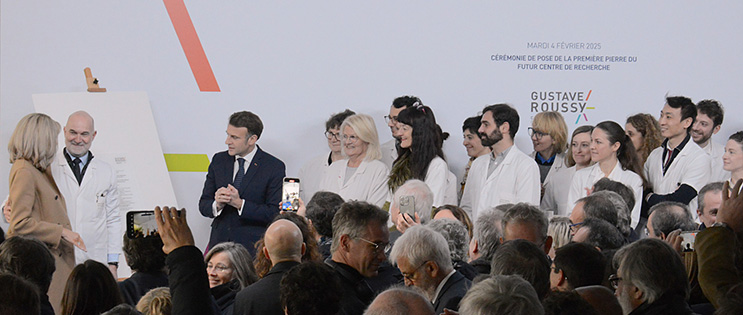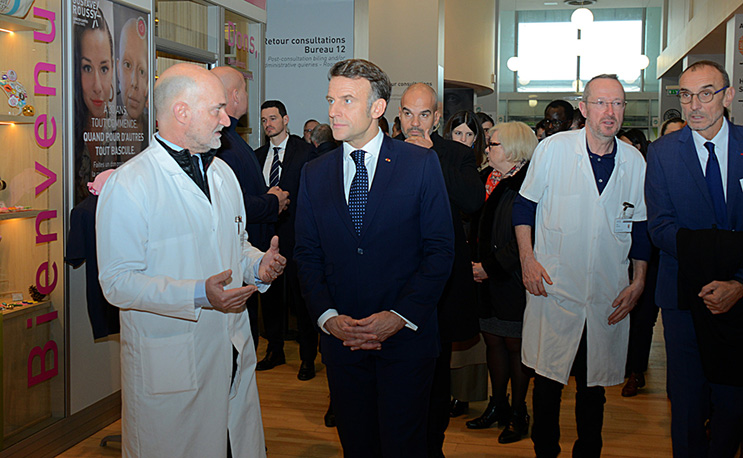The President of the French Republic lays the foundation stone for Gustave Roussy’s new research building
The laying of the foundation stone marks a decisive milestone in developing the Paris-Saclay Cancer Cluster, which is currently being established around Gustave Roussy and is set to become the largest oncology hub in Europe.
On Tuesday, 4 February, World Cancer Day, President Emmanuel Macron and First Lady Brigitte Macron visited Gustave Roussy, accompanied by five ministers, including Elisabeth Borne, Minister of State, Minister of National Education, Higher Education and Research; Catherine Vautrin, Minister of Labour, Health, Solidarity and Families; Philippe Baptiste, Minister Delegate for Higher Education, and Research; Yannick Neuder, Minister of Health and Access to Care; Clara Chappaz, Minister Delegate for Artificial Intelligence. Also in attendance were Etienne Stoskopf, Prefect of Val-de-Marne; Marc Guillaume, Prefect of Île-de-France; Valérie Pécresse, President of the Île-de-France Regional Council; Olivier Capitanio, President of the Val-de-Marne Departmental Council; Pierre Garzon, Mayor of Villejuif; Michel Leprêtre, President of the Grand-Orly Seine Territorial Public Establishment; Denis Robin, General Director of the Île-de-France Regional Health Agency; Professor Fabrice Barlesi, General Director of Gustave Roussy; and Professor Eric Vivier, President of the Paris-Saclay Cancer Cluster.

During this official visit, President Emmanuel Macron and Professor Fabrice Barlesi laid the foundation stone for the Institute’s new research building, which is scheduled for completion by late 2027.
32,000 m2 dedicated to research
This new 32,000 m² building has been designed to foster synergies between researchers. It will house 60 internationally renowned teams and will feature 12 cutting-edge technological platforms.
Among these, infrastructures dedicated to data analysis, organoids, and rare circulating cells will help advance oncology research and accelerate scientific discoveries for the benefit of patients.

An ambitious master plan for infrastructure
The President’s visit also allowed Professor Barlesi to present the “Campus Grand Parc,” which is currently under development around Gustave Roussy.
In addition to the new research centre, the Institute’s master infrastructure plan includes the construction of a 13,600 m2 building to accommodate the Interception prevention program, the Instadiag rapid diagnostic pathways, as well as outpatient and international patient services. Another 32,000 m2 building will house administrative and teaching facilities, including a multi-storey car park and a large lecture hall.
With these new facilities, Gustave Roussy reaffirms its ambition to remain at the forefront of innovation in oncology and to offer patients the latest scientific and medical advances.
Meeting with Gustave Roussy researchers
During this official visit, Professors Fabrice Barlesi and Eric Vivier presented the activities of the Paris-Saclay Cancer Cluster to the President, of which Gustave Roussy is a founding member.
President Macron then met with several of the Institute’s researchers and their teams to discuss topics such as data science and artificial intelligence applied to oncology research, resistance mechanisms to innovative therapies, paediatric cancers, and cellular therapies. This was followed by an exchange with patients and healthcare professionals.
“The President’s visit and the laying of this foundation stone are an honour for Gustave Roussy and a strong signal of national commitment to the fight against cancer. This new research building, designed to foster innovation and scientific collaboration, embodies our ambition to transform discoveries into tangible progress for patients. With the support of public authorities and our partners, we are reaffirming our position as the European leader in oncology and our determination to tackle the major challenges of tomorrow” concluded Professor Fabrice Barlesi.
